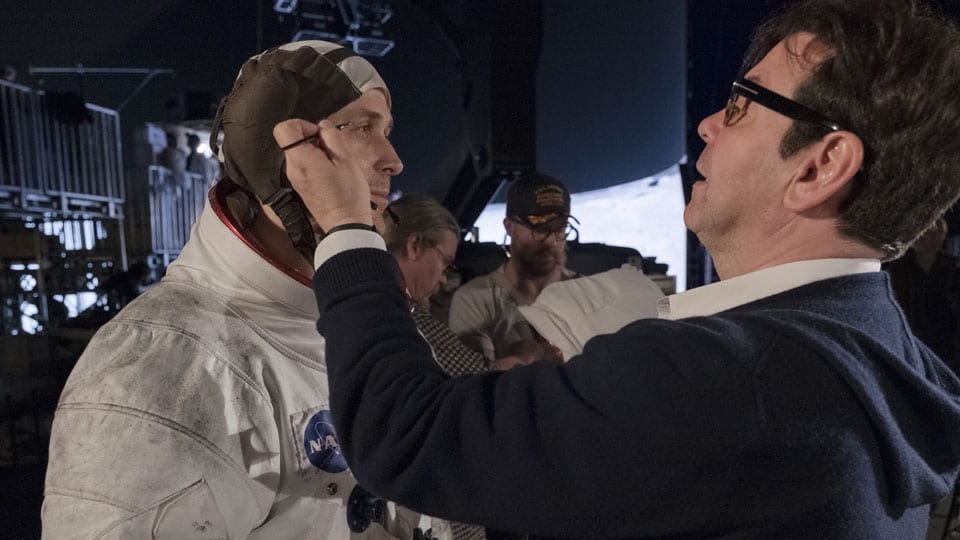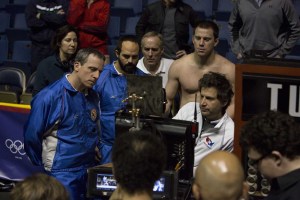
Director Bennett Miller was unfamiliar with the story when a stranger approached him at an event in New York City and offered him an envelope full of newspaper clippings. A few weeks later when Miller read the articles in the package, he was taken by the story, which is based on true events. Over time, as Miller researched and investigated what had happened, the story’s pull on him got stronger.
“The immediate thing that hooked me had to do with the relationships of these people that seemed so bizarre,” shared Miller. “One of the wealthiest men in America had a team of wrestlers living on his property. I really didn’t need much more information than that to be completely captivated. I just wanted to know.”
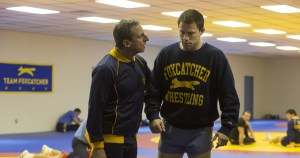
A great deal of archival material formed the basis for Miller’s cinematic vision for the film. In addition, he made trips to the area of du Pont’s Foxcatcher Farm, absorbing the culture, topography and books of that region and era. He developed a visual blueprint of photographs. “As it was being written I made a slide show, like a movie piece of the film, that came about quickly,” Miller said. “It was used to inform, all the way up until the shoot.”
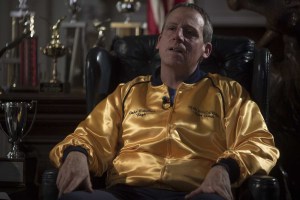 Although Foxcatcher was their first feature collaboration, Miller had established a working relationship with cinematographer Greig Fraser on a couple of commercials. The film’s cinematography had an austere style, a deliberate stillness that concentrated the viewers’ awareness onto the subtleties of the performance and the nuances of the scenes. The camera only moved where it needed to and only cut when it needed to, creating an observational quality to the movie.
Although Foxcatcher was their first feature collaboration, Miller had established a working relationship with cinematographer Greig Fraser on a couple of commercials. The film’s cinematography had an austere style, a deliberate stillness that concentrated the viewers’ awareness onto the subtleties of the performance and the nuances of the scenes. The camera only moved where it needed to and only cut when it needed to, creating an observational quality to the movie.
“It’s a film that observes more than it tells a story,” explained Miller. “What the film focuses on largely exists beneath the surface, beneath the dialog. There is so much that’s unspoken. It’s about the mounting tensions and dynamics between these people. So the style of the film – what would inform the cinematography as well as all other aspects including production design and costume design and music and editing – the style of the film is meant to sensitize you to what’s happening beneath the surface.”
Once the filmmakers committed to this controlled style, born out of Miller’s goal to draw the viewer into looking deeper, the execution became delicate. “It is unforgiving,” according to Miller. “It amplifies everything. Any glitch in a performance or in a dolly move is going to glare. The film is asking you to look further, look deeper, watch carefully. To be still yourself. All of that is communicated through the mind of the film and the mind of the photography.”
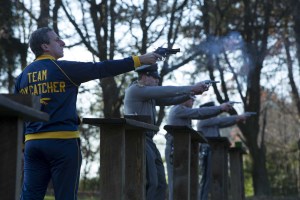 The director worked on the film with three editors, Jay Cassidy, Stuart Levy and Conor O’Neill. As with the cinematography, and the whole film for that matter, there is a specific language to the editing. “Everyone is working to serve the style and the tone of the edit,” commented Miller. “If you have a trio of editors, it’s probably similar to working with musicians. Keeping them in key and on beat. If something veers off-style, it’s not difficult to identify it. It does take a while, but there is a rigid set of rules about what’s legal and what’s not legal in this style. It’s something all three of these guys could grasp. They really did adopt the style.”
The director worked on the film with three editors, Jay Cassidy, Stuart Levy and Conor O’Neill. As with the cinematography, and the whole film for that matter, there is a specific language to the editing. “Everyone is working to serve the style and the tone of the edit,” commented Miller. “If you have a trio of editors, it’s probably similar to working with musicians. Keeping them in key and on beat. If something veers off-style, it’s not difficult to identify it. It does take a while, but there is a rigid set of rules about what’s legal and what’s not legal in this style. It’s something all three of these guys could grasp. They really did adopt the style.”
Miller has been working with production designer Jess Goncher for 15 years. Beginning with commercials, their collaboration continued on Capote and Moneyball. Miller credits Goncher with getting both the big picture and the nuanced details of the little picture.
“Filmmaking is authoring and every department has authors. He really is somebody who authors his department,” said Miller. “It’s gotten to such an extent that I asked Jess to assume the additional role of second unit director on Foxcatcher. He has such a grasp on the language that we’re using. He really is a collaborator who requires not that many words. I would feel insecure if, for some reason, he was unavailable.”
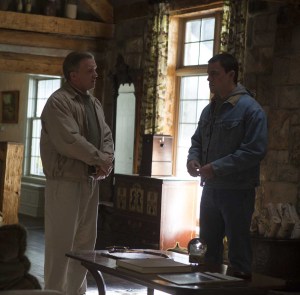 Miller believes in breaking down the barriers between departments so everyone is working on the same film. With all his collaborators, the director likes to talk about the details of their jobs but also likes to get his team together as a group and get them involved in the conversation about the big picture so they can understand the contributions of other members of the team. They talk about what each character and scene is really about, both on and below the surface, as well as determine what’s literal or where they might be striving for something allegorical.
Miller believes in breaking down the barriers between departments so everyone is working on the same film. With all his collaborators, the director likes to talk about the details of their jobs but also likes to get his team together as a group and get them involved in the conversation about the big picture so they can understand the contributions of other members of the team. They talk about what each character and scene is really about, both on and below the surface, as well as determine what’s literal or where they might be striving for something allegorical.
Miller discussed the film at length with Goncher and costume designer, Kasia Walicka-Maimone, going through the script “scene by scene, chapter by chapter, act by act.” There comes a time when they totally understand the style of the film. Then Miller only needs to discuss final approvals.
Film is the most collaborative art form, incorporating other art forms such as orchestral music. For the film, composer Rob Simonsen worked with a 75-piece orchestra to record the score. For a number of years, Simonsen assisted Mychael Danna, Miller’s composer on Capote and Moneyball. Danna invited Simonsen to collaborate on a few cues for Moneyball. “They really worked beautifully,” commented Miller.
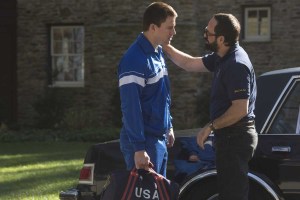 Although Danna contributed a major theme for Foxcatcher, the composer was unavailable to make the tight deadline for completing the film. Without his regular composer, Miller was faced with finding someone else to score the picture. “I was temping with a cue that I had gotten from our music supervisor,” Miller said. “It became a really signature cue to the film.” The director didn’t know who had written that cue, but found out from the music supervisor it had been written by Rob Simonsen and had never been used in any film. The fortunate happenstance allowed Miller to keep the cue in the film and bring Simonsen, who he had already worked with previously, on as composer. “It made so much sense,” added Miller. “It was one of those great coincidences.”
Although Danna contributed a major theme for Foxcatcher, the composer was unavailable to make the tight deadline for completing the film. Without his regular composer, Miller was faced with finding someone else to score the picture. “I was temping with a cue that I had gotten from our music supervisor,” Miller said. “It became a really signature cue to the film.” The director didn’t know who had written that cue, but found out from the music supervisor it had been written by Rob Simonsen and had never been used in any film. The fortunate happenstance allowed Miller to keep the cue in the film and bring Simonsen, who he had already worked with previously, on as composer. “It made so much sense,” added Miller. “It was one of those great coincidences.”
Consistent with the other elements of the film, the music is not narrative and does not represent the perspective of any individual character. Unlike typical underscore, the music is not meant to be a communication of what the character is feeling and going through. “It is an expression of the mind of the film,” shared Miller. “The music gives a context so that if there is a moment of terror or horror or triumph in the film, the music is never echoing that sentiment — ever. Instead it offers another perspective to give context to what we’re seeing. The context is always from another perspective from the characters, which is another way of saying that the characters don’t hear the music.”
“Even in the most horrific and tragic moments of the film, the music is not frenetic or unsettling,” continued Miller. “It has poise and space and allows you to really look at what’s happening in an unflinching way. That is a fundamental challenge. Rob has to summon the mood and the feeling of how we are looking at the film. Also, because the film has a deliberate, precise style, the music is there in part to help sensitize us and focus us to the subtleties of what we are seeing.”
The sound was as important as any other aspect of the film. “I worked with the truly fantastic sound designer and editor Paul Hsu,” commented Miller. “Paul is really an artist. When I think of what he does, it’s part of the score as well, because it’s so musical and subtle. The sound has a similar approach to the music. It is responsible for creating space, sensitizing you, summoning moods, transitioning from one dimension to the next without calling attention to itself.”
The film was mixed with Deb Adair in Los Angeles who had worked with the director on Moneyball. A couple months later, they finished the mix with re-recording mixer Tom Fleischman in New York.
Miller feels the craft side of filmmaking does not receive enough attention. Throughout the process he built enduring relationships.
“When it comes down to it, the people who make the film, who are in the trenches, whose skill and labor and commitment the film relies upon, for some reason don’t get quite the acknowledgement and appreciation,” Miller said. “I feel extremely fortunate to have collaborated with everybody on this film. I would like to work with these people again and again and continue to define these relationships. I wouldn’t be surprised if the credits on Foxcatcher are awfully close to those of whatever my next film is.”




